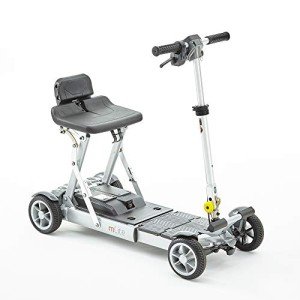Understanding Mobility Devices: Enhancing Independence and Quality of Life
In today's hectic world, the desire for mobility is universal. However, certain medical conditions or age-related obstacles can prevent movement, leading to a continuous look for assistance. folding mobility scooters with long battery life serve as necessary tools to boost self-reliance, enhance quality of life, and enable people to engage totally in their communities. This article provides an extensive summary of mobility devices, including their types, features, selection requirements, and more.
Types of Mobility Devices
Mobility devices vary from simple aids to complex equipment, customized to satisfy different requirements. Below is a table summing up typical kinds of mobility devices:
| Type of Device | Description | Perfect For |
|---|---|---|
| Walkers | Four-legged support devices that provide superior stability while walking. | People needing additional support. |
| Walking canes | Single or three-legged sticks that enhance balance and assistance walking. | Those with slight mobility difficulties. |
| Wheelchairs | Seats installed on wheels, offered in manual and electric variations. | Individuals with minimal or no mobility. |
| Scooters | Electric lorries created for outdoor usage and ease of navigation. | Those who can't walk cross countries. |
| Crutches | Devices that help people transfer weight away from a hurt leg. | People recuperating from leg injuries. |
| Rollators | Walkers with wheels, seats, and brakes for improved mobility. | Users needing rest alternatives while walking. |
| Raise Chairs | Reclining chairs that assist users in standing up and sitting down. | Seniors or those with mobility constraints. |
| Mobility Scooters | Small electric cars for minimal mobility, typically used outdoors. | Individuals needing help over long ranges. |
Key Features of Mobility Devices
When selecting a mobility gadget, a number of key functions must be thought about to make sure optimum functionality and ease of use:
- Weight Capacity: Understanding the gadget's weight constraint is essential for safety and efficiency.
- Adjustability: Devices should be adjustable in height and width to fit the user conveniently.
- Portability: Lightweight and foldable options are vital for users who travel or require transportation.
- Stability and Safety: Look for functions like anti-tip wheels and strong structures to boost safety.
- Alleviate of Use: Simple systems and user-friendly designs can make a substantial difference in day-to-day usage.
- Comfort: Ergonomic designs and padded seats can boost the user experience.
Picking the Right Mobility Device
Choosing the right mobility device can be a difficult job. Here are some actions to assist the decision-making process:
- Assess Needs: Evaluate the person's mobility challenges and everyday activities.
- Speak with a Professional: Engage health care professionals who can supply recommendations based upon the individual's physical condition.
- Trial Options: If possible, trial various devices to determine comfort and performance.
- Evaluation Budget: Consider the expense of the device, consisting of any extra features or modifications needed.
- Research study Options: Determine the very best brands and models by reading reviews and comparisons.
Table: Comparative Analysis of Popular Mobility Devices
| Gadget | Advantages | Drawbacks |
|---|---|---|
| Walkers | Excellent stability, promotes walking. | Bulky, might restrict motion in small spaces. |
| Walking canes | Lightweight, improves balance. | May not offer enough support for severe mobility concerns. |
| Wheelchairs | Ideal for those with significant mobility constraints. | Can be cumbersome, particularly in indoor environments. |
| Scooters | Great for outdoor usage, easy to maneuver. | Minimal indoor use, much heavier. |
| Rollators | Provides rest option, simple to move. | May need more space than conventional walkers. |
| Lift Chairs | Comfortable, assists transition from sitting to standing. | More expensive, bigger footprint. |
Often Asked Questions (FAQs)
1. What is a mobility device?
A mobility device is any tool designed to assist people in moving and navigating their environment. This includes walkers, wheelchairs, scooters, and crutches.
2. How do I understand which mobility gadget is best for me?
Consider your specific mobility difficulties, physical capabilities, and lifestyle needs. Consulting with healthcare professionals can likewise supply tailored recommendations.
3. Are mobility devices covered by insurance?
Numerous insurance coverage plans, consisting of Medicare, may cover specific mobility devices. It's important to talk to your insurance coverage service provider for particular protection information.
4. Can I lease a mobility device instead of buying one?
Yes, lots of medical supply stores and drug stores use leasings for mobility devices. This option is beneficial for individuals with momentary mobility issues.
5. How can I maintain my mobility gadget?
Regular maintenance is essential. It includes cleaning up the gadget, inspecting for wear and tear, and ensuring all parts are operating correctly.
The Impact of Mobility Devices on Quality of Life
Mobility devices considerably enhance the lifestyle for individuals with minimal mobility. They foster self-reliance, motivate social interaction, and enhance access to essential services and leisure activities.
- Increased Independence: Users can browse their communities, participate in events, and engage in hobbies without relying on others.
- Social Engagement: Mobility devices help with participation in celebrations, therefore combating sensations of isolation.
- Enhanced Safety: Devices provide stability and decrease the danger of falls, promoting user confidence.
Mobility devices are more than simply tools for movement; they are entrances to independence and quality living. By understanding the various kinds of mobility aids available, their key functions, and considerations for selecting the ideal device, people can make educated choices about their mobility needs. Ultimately, the right mobility gadget can result in a more active, fulfilling life. Whether it's a walker, wheelchair, or scooter, the best choice contributes substantially to improving the mobility and self-reliance of users.

